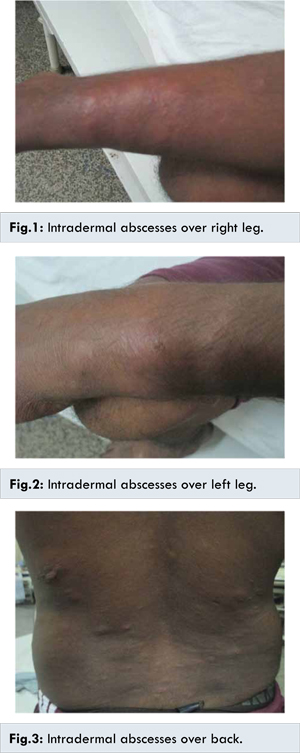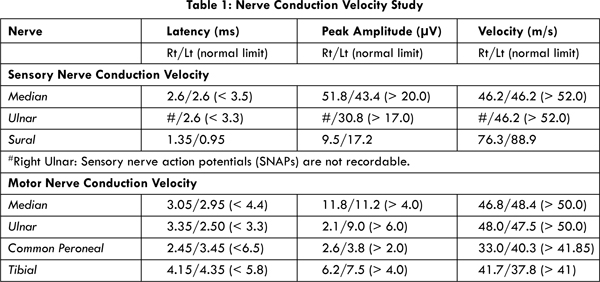Introduction
Leprosy, first described in ancient Indian texts from the sixth century BC, is a chronic infectious disease caused by Mycobacterium leprae, the clinical manifestations of which are largely confined to the skin, peripheral nervous system, upper respiratory tract, eyes, and testes. Leprosy is a communicable disease which if untreated results in characteristic deformities [1]. The Ridley-Jopling classification divides leprosy into 3 major categories: tuberculoid leprosy, lepromatous leprosy, and borderline leprosy. It is confirmed by slit-skin smears, skin biopsy, and nerve biopsy. Herein we describe the clinical case of a leprosy presenting as multiple intradermal abscesses in a 30-year-old male.
Case Report
A 30 years old male, labourer, resident of District Mau, Uttar Pradesh presented in our outdoor patient with chief complaints of fever for 6 months and multiple abscesses all over the body predominantly on lower limbs and back for 3 months [Fig.1-3]. These abscesses were steadily increasing. This was accompanied by undocumented fever. He was taking treatment for same complaints but was not relieved so he was referred to our institution. We reviewed history again and found a new complaint of numbness along the right little finger which was increasing gradually. He had no history of diabetes mellitus, drug allergy, steroid intake, alcoholism or any similar episodes of skin lesions suggestive of leprosy in past.

His physical examination demonstrated normal general physical examination with vitals in normal limits. His cardiac, respiratory and abdominal examinations showed no abnormality. On neurological examination motor systems of both limbs were intact with normal gait. Deep tendon reflexes were preserved and bilateral plantars were flexor. Sensory examination revealed loss of touch and temperature along the right little finger. On clinical examination the peripheral nerves were not thickened except right ulnar nerve.
On admission his routine investigations showed hemoglobin 9.6 gm/dL, total leukocyte count was 13860/µL, differential count was polymorphs: 80%, lymphocyte: 05%, monocyte: 11%, eosinophil: 4%, and platelets count were 1,54,000/mm3. His random blood sugar: 110 mg/dL, serum sodium: 130 meq/L and serum potassium: 5.1 meq/L were within normal limits. Renal, liver and thyroid function tests showed no abnormality. Enzyme-linked immunosorbent assay for human immunodeficiency virus, Australia antigen for Hepatitis B and antibody against Hepatitis C virus were negative. High resolution ultrasonography of skin revealed multiple intradermal micro-abscesses. Nerve conduction velocity (NCV) study of bilateral upper and lower limbs showed right ulnar neuropathy [Table 1]. Slit skin smear examination from both the ear lobules and two lesion sites revealed presence of acid fast bacilli while right and left nasal smears were negative for acid fast bacilli (According to Ridley’s Logarithm Scale Bacterial Index: 1.6 & Morphological Index: 50%). He was diagnosed to have borderline lepromatous leprosy and he was put on multibacillary multidrug therapy. Patient started improving and got discharged. Now patient is on our follow up and his skin abscesses has resolved completely.

Leprosy presents as a spectrum of clinical manifestations that have bacteriologic, pathologic, and immunologic counterparts. The spectrum from polar tuberculoid (TT) to borderline tuberculoid (BT) to mid-borderline (BB, which is rarely encountered) to borderline lepromatous (BL) to polar lepromatous (LL) disease is associated with an evolution from asymmetric localized macules and plaques to nodular and indurated symmetric generalized skin manifestations, an increasing bacterial load, and loss of M. leprae specific cellular immunity [1]. The different manifestations of leprosy such as - numb hypopigmented or erythematous patches, localized paresthesia, shooting pains blisters of hands and feet, motor weakness, nasal stuffiness, epistaxis, synovial swelling of wrist, pedal edema, painless nodule, diminished over-excessive sweating have been reported [2]. Atypical presentations of leprosy like laryngeal dyspnoea, bullae with hematoma [3], xanthoma [4], facial nerve abscess [5], granulome annulare and erythema multiforme [6] has also been demonstrated in literature.
Our case highlights the unusual presentation of leprosy as patient had multiple abscesses all over the body. Leprosy was suspected in this patient because he was native of an endemic area and presented with skin lesions and peripheral neuropathy. Due to variable clinical presentations, it becomes very important to make correct diagnosis. Complications of the extremities in leprosy patients are primarily a consequence of neuropathy leading to insensitivity and myopathy. Insensitivity affects fine touch, pain, and heat receptors but generally spares position and vibration appreciation. Ulnar nerve is most commonly affected which results in clawing of the fourth and fifth fingers, loss of dorsal interosseous musculature and loss of sensation in these distributions [1].
Conclusion
With above description it is very necessary that every case of suspected skin lesions should be examined properly and investigated accordingly. Because of variable clinical presentations of leprosy, it sometime becomes difficult to make correct diagnosis. Early diagnosis and management will be very helpful in eradication of leprosy.
References
- Gelber RH. Leprosy. In: Longo DL, Fauci AS, Kasper DL, Hauser SL, Jameson JL, Loscalzo J et al. editors. Harrison’s principles of internal medicine. 18th ed. New York: McGraw Hill; 2012, pp.1359-1367.
- Sharma VK. Leprosy: Classification and clinical features. IADVL Text book of Dermatology. 3rd ed. pp. 1578-601.
- Bentekan L, Hassam B. Atypical presentations of leprosy: Apropos of 2 cases. Acta Leprologica. 1997;10:195-198.
- Suzuki Y, Takigawa M, Ishii N. A case of suspected multibacillary leprosy. Nihon Hansenbyo Gakkai Zasshi. 2003;72:287-290.
- Thomas M, Emmanuel M. Facial nerve abscess in a case of leprosy: A case report. Neuro Asia. 2009;14:41-42.
- Das S, Roy AK, Kar C, Giri PP. Atypical presentation of leprosy: A report of two cases. Indian J Dermatol. 2007;52:198.